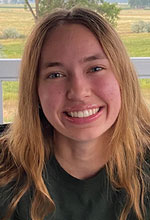AIST Foundation Steel Intern Scholarship
 Grace M. Ekness
Grace M. Ekness
Steel dominates an integral part of today’s modern world, such as in structures and transportation which are used extensively throughout every day. Therefore, the opportunity of becoming an intern at one of the largest steel producers in North America proved too good to turn down.
Within the realm of metallurgy, two broad categories emerge: extractive and physical. Extractive metallurgy involves obtaining iron ore from the earth. Then with further mineral processing, purifying the ore until the desired elements are attained. Steelmaking involves both extractive and physical metallurgy. Here at Nucor though, physical metallurgy is the focal point. Physical metallurgy includes the exploitation of a materials composition, as well as the structure and properties of that material. As a metallurgical and materials engineering intern at a Nucor bar mill facility, utilizing knowledge based on information learned at university is essential.
 During the first few weeks of the internship, I spent time getting to learn the process and went to different pulpits throughout the plant. Nucor Kankakee employs four metallurgists who contribute to the operation and success of the mill. At the beginning of internship, time mostly spent with the melt shop metallurgist provided insight to the operation. Including making sure the chemistry of the steel being produced meets the predetermined requirements. Along with going over the necessary steps to take when chemistry does not meet the requirements. Most Nucor facilities operate using one hundred percent recycled steel — including Kankakee — which introduces unwanted elements into the steel, with the main residual element being chromium. For steel to meet the desired properties, it is essential for the strengthening elements carbon, manganese, vanadium and niobium to be within certain specifications.
During the first few weeks of the internship, I spent time getting to learn the process and went to different pulpits throughout the plant. Nucor Kankakee employs four metallurgists who contribute to the operation and success of the mill. At the beginning of internship, time mostly spent with the melt shop metallurgist provided insight to the operation. Including making sure the chemistry of the steel being produced meets the predetermined requirements. Along with going over the necessary steps to take when chemistry does not meet the requirements. Most Nucor facilities operate using one hundred percent recycled steel — including Kankakee — which introduces unwanted elements into the steel, with the main residual element being chromium. For steel to meet the desired properties, it is essential for the strengthening elements carbon, manganese, vanadium and niobium to be within certain specifications.
Internships are valuable opportunities to employ knowledge gained in a classroom where you have the opportunity to apply your education into real world contributions. I’m thankful I had the experience to utilize past skills and developing new soft and technical skills to accomplish the fundamental task of any metallurgist or engineer for that matter to solve problems.
